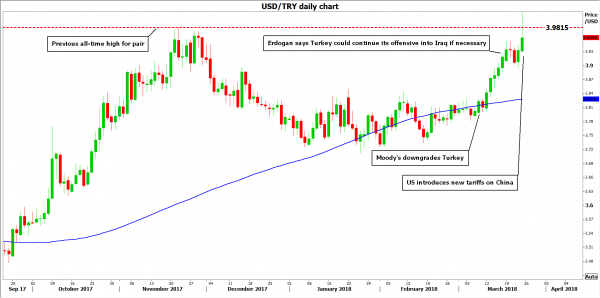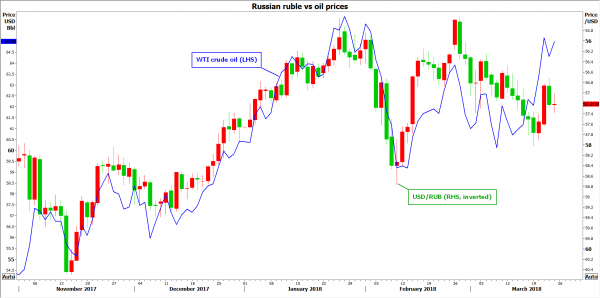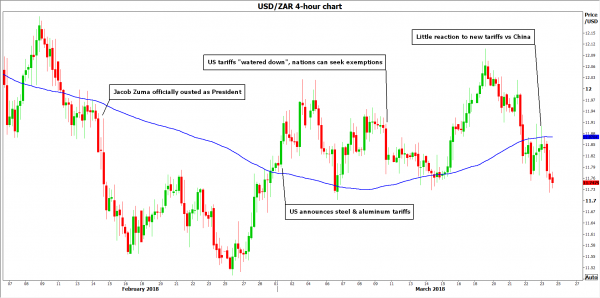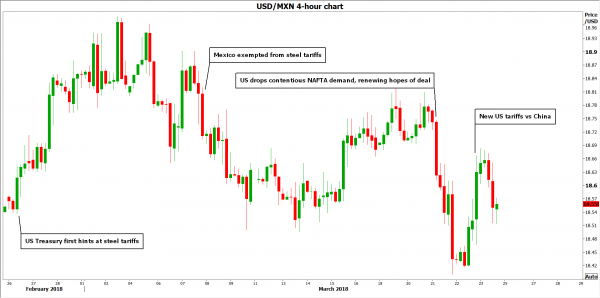The past few weeks have seen very interesting developments in emerging markets (EM). Some EM currencies have plunged, as rising concerns over a tit-for-tat global trade war amplified the already-troubled outlook for those economies. Others, however, have managed to hold their own quite well so far, defying the conventional wisdom that EM economies are the most exposed to the threat of increased protectionism.
The possibility of a retaliatory trade war appears increasingly more realistic with every passing day. The latest US tariffs on China, and the Chinese pledge to respond in kind, have caused investors to shy away from risky assets and to seek the safety of havens like the yen. Meanwhile, economic theory would suggest that emerging markets are also likely to feel the heat, as carry trades are unwound and capital flees those nations. How have prominent EM currencies performed in reality though?
Turkish lira – In dire straits
The Turkish lira is the worst performing currency this month, down 4.4% against the dollar and 5.3% versus the euro. It’s down a whopping 6.2% with the yen. In fact, the lira has recorded fresh all-time lows against all three (USD, EUR, JPY) this month, marking new milestones in the currency’s multi-decade downtrend. What is most striking is that the lira is at an all-time low against the dollar even in a period when the dollar is a major underperformer itself.
Concerns over global trade have clearly weighed on the currency, which was among the biggest losers following the new US tariffs on China. Besides trade woes though, the lira’s weakness is also owed to a worrisome cocktail of economic and political developments. Economically, core inflation stands well-into the double digits (roughly 12%) and while the central bank has adopted a hawkish tone, it has not raised rates materially enough to rein in inflation. The lack of concrete action enhances concerns over the Bank’s independence, considering President Erdogan’s frequent criticisms of high interest rates. Then there is the country’s widening current account deficit, signaling Turkey is increasingly reliant on foreign demand and would thus be vulnerable should risk appetite falter in markets, as is the case now. A downgrade of Turkey’s credit rating by Moody’s last week didn’t do the lira any favors either. Politically, Turkey’s deteriorating relationship with the US, as well as its military operations in Syria and potentially in Iraq soon, are other sources of anxiety.
Judging by the lira’s sensitivity to the latest US tariffs, the currency is likely to continue underperforming in case the situation escalates further, not least due to Turkey’s ballooning current account deficit and the capital flight that appears to be occurring. A factor that could limit further declines though, is the central bank. While it has not taken decisive action yet, if the lira weakens even more, it may choose to “defend” the currency by raising rates, an action that would also benefit the country’s inflation outlook.
 Russian ruble – Down, despite higher oil prices
Russian ruble – Down, despite higher oil prices
The Russian ruble is also down so far this month. It’s 1.3% lower against the dollar, and 2.6% versus the euro. In general, the currency is being dragged lower by the Bank of Russia, which has cut rates in 8 out of its 9 latest meetings in order to lift inflation. Additionally, political uncertainties have returned after the UK accused Russia of poisoning an ex-Russian spy on British soil, generating speculation that the West could impose fresh economic sanctions on Moscow. On the flipside though, oil prices have surged recently and since oil is Russia’s largest export, the ruble has enjoyed some demand, limiting larger declines in the currency.
In terms of tariffs and trade risks, the ruble did weaken after the initial announcement of US steel tariffs, but did not react much to these risks thereafter. A plausible explanation for that may be that while Russia does export some metals, its predominant export is oil, and no nation has so far mentioned tariffs on energy products. Thus, while the ruble could be negatively impacted by a further escalation in tensions, its downside may not be too large, unless of course Russia’s energy exports come under threat.
The currency’s forthcoming direction will also hinge on movements in oil prices, as well as expectations around the possibility of fresh sanctions by the US and EU.
 South African rand – Surprisingly resilient
South African rand – Surprisingly resilient
The South African rand has been performing relatively well this year, even amid a domestic political shakeup and global trade uncertainties. Specifically, the rand is up by nearly 5% against the dollar this year, and 2.2% higher against the euro. The ousting of Jacob Zuma from the Presidency in mid-February was a very pleasant development for the currency, which rallied on speculation his exit would usher in a new era of much-needed structural reforms.
Moreover, the rand was not hit as hard as one would expect from trade risks. Month-to-date, the currency is 0.8% lower versus the euro, but practically unchanged against the dollar. This is quite peculiar, as South Africa exports a broad variety of commodities, rendering its economy vulnerable to increased protectionism. That said, among those commodities are many precious metals like gold that have appreciated given the recent turmoil, a factor that has probably helped to offset any serious losses in the rand.
In the near-term, the currency’s performance is likely to depend on an upcoming credit rating review by Moody’s due later today, and a rate decision by the South African Reserve Bank (SARB) on March 28. Moody’s is the last remaining major ratings agency with an “investment grade” rating on South African debt, and in case of a downgrade to “junk”, the rand could come under selling interest as outflows intensify. Meanwhile, markets appear split on whether the SARB will cut rates next week, which represents another risk event for the currency.
 Mexican peso – Higher, despite trade risks
Mexican peso – Higher, despite trade risks
The Mexican peso, meanwhile, has practically become a liquid proxy for the NAFTA negotiations, rallying on signs of progress in the talks and tumbling when the likelihood of a successful deal is seen as declining. While the peso lost some ground in early March after the US announced its steel tariffs, it quickly recouped its losses after Mexico was exempted from those levies. Then, the currency gained further following reports the US will drop one of its most contentious NAFTA demands, which was a “thorn” in the talks.
Strikingly, the peso is higher against the euro and the dollar, both month-to-date and year-to-date. To be fair, the currency has also enjoyed some support from monetary policy, with the nation’s central bank hiking rates at both of its latest meetings in an effort to tame above-target inflation.
The next round of NAFTA negotiations is scheduled for mid-April, though no exact date has been announced. This is seen as a “make or break” round of talks, as it will probably be the last one before Mexico’s general election on July 1. According to media reports, all sides realize there needs to be a breakthrough before that date, as the elections will probably complicate and prolong the negotiations. The peso’s fortunes will likely be determined by whether these talks bear fruit; remember that nearly 80% of all Mexican exports go to the US.













